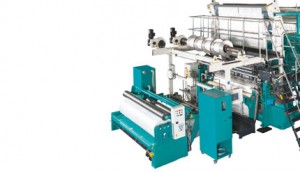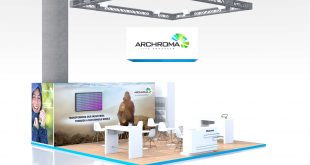 A great deal of potential lies in exploiting synergistic effects – as the latest development from KARL MAYER MALIMO shows. This textile machinery manufacturer, which specialises in technical textiles, has combined the key components of its RS MSUS-V machine with biaxial technology and developed a biaxial machine featuring weft insertion in line with the courses. This new innovation is known as the Biaxtronic® CO (Fig. 1).
A great deal of potential lies in exploiting synergistic effects – as the latest development from KARL MAYER MALIMO shows. This textile machinery manufacturer, which specialises in technical textiles, has combined the key components of its RS MSUS-V machine with biaxial technology and developed a biaxial machine featuring weft insertion in line with the courses. This new innovation is known as the Biaxtronic® CO (Fig. 1).
Compared to the conventional version, this new composite machine offers an improved cost:benefit ratio and advantages in terms of its operation and maintenance. But above all, the quality of the product has changed – an important advantage, particularly for the Chinese wind turbine market. There, manufacturers of multiaxial structures for the blades of wind turbines want a construction containing weft yarns that are not pierced during the knitting process
General textile characteristics
As with all stitch-bonded biaxial textiles, the fabrics produced on the Biaxtronic® CO are made up of zero inlays and weft yarns and, if required, an additional base web, such as a chopped glass strand mat or a nonwoven. The two reinforcing yarn systems are inserted absolutely straight and parallel at angles of 0 and 90º and fixed in place by stitches. This avoids variations caused by the construction, which lead to loss of strength and undesirable stretching with woven fabrics. Most machines on the composites market operate on the basis of weft insertion that is not in line with the courses but, with this new technology, the weft yarns are inserted in line with the courses. The weft yarns are not pierced or damaged. On the one hand, this enables higher strength levels to be achieved when using conventional materials. On the other hand, new yarn combinations can be used for the same strength values, e.g. a heavy zero inlay layer with very thin weft yarns with defined spaces between the yarns.
Technical features
The Biaxtronic® CO is available in working widths of 100″, 101″ and 102″. The gauges available as standard are E 5, E 6, E 7 and E 10. The standard features also include the KAMCOS®system, an N-drive with a maximum of three pattern discs, an operating interface with 12.1″ touchscreen monitor, and a warp beam frame with one or two warp beam positions. An electronically controlled yarn let-off drive is available for each mounted warp beam. The maximum flange diameter of the sectional warp beams is 32″. The zero inlays are delivered via electrically driven delivery rollers from creels (Figs. 2 + 3). The tried-and-tested MSUS system is responsible for weft insertion: the weft laying device draws 24 reinforcing yarns from the weft creel and inserts them into the hooks of a transport chain (Fig. 4). A complementary laying device runs ahead of the weft-laying device, which ensures that all the yarns are taken off at the same tension and speed. The yarn layers are fed to the knitting point via the transport chain. The knitting elements are also similar to those of a weft-insertion warp knitting machine, and include a compound needle and closing wire bar, knock-over sinker bar, zero inlay bar, counter retaining bar with support rail, and one or two ground guide bars for stitch formation (Figs.5). Every yarn is tied-in in a stitch at the knitting point to bond the structure of the textile. An electronically controlled 3-roller system is responsible for takedown of the final reinforcing textile. The panel fabric can be cut into strips by a cutting mechanism located in front of the batching unit. It can be cut into a maximum of 18 pieces. A synchronised or torque-controlled batching unit with a capacity of up to 4 tonnes per roll is available for fabric take-up. The maximum diameter of the roll is 1,170 mm.
Optimum output and quality
The Biaxtronic® CO combines the latest materials with complex design solutions, especially in terms of the drive technology and the weft insertion system. These optimised features enable this high-performance machine to reach speeds of up to 1,400 min-1 and to achieve maximum production rates of 6.5 m/min. The weft laying frequencies are also extremely high. The Biaxtronic® CO produces top-quality products, despite its high speeds. In particular, the continuous transport belt for feeding the chopped glass strands under the yarn layers produces textiles with no faults. This system guarantees that the chopped glass strand mat and the weft layer are kept separate at all times. With its intelligent weft yarn management system, the Biaxtronic® CO also produces a top-quality product: the 90º reinforcing yarns are inserted accurately and handled gently, thanks to the use of a complementary laying device as a yarn compensator. Yarn feed at the weft-laying device has also been improved to further reduce stressing of the yarns. Feeding-in of the zero inlays has also been improved, i.e. the use of four separate delivery units ensures that the individual yarns are kept separate – a necessary requirement in view of the heavy weights involved.
A taste of its skill offered the Biaxtronic® CO during an open-house event held from 18. to 20. November 2014 at KARL MAYER (China) Ltd. in Changzhou City. The customers’ response to this newcomer was very good; showing that KARL MAYER’s latest development fully satisfies the market requirements.
 Tekstil Teknik Dergisi Tekstil Haberleri, Tekstil Sektörü, Tekstil Teknik
Tekstil Teknik Dergisi Tekstil Haberleri, Tekstil Sektörü, Tekstil Teknik




